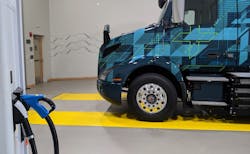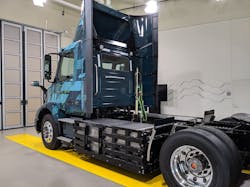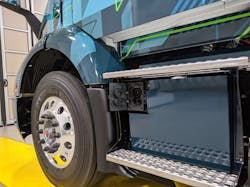Volvo’s first electric VNR ready for the road
Volvo Trucks North America plans a late-2020 regional rollout of its first Class 8 battery-electric vehicle. One of the first VNR Electric vehicles was shown off for the first time during the company’s 2019 Technology Summit last week in Dublin, VA at Volvo’s New River Valley plant, where it will be built.
The first five VNR Electric trucks will be delivered to select California customers this year as part of Volvo’s LIGHTS (Low Impact Green Heavy Transport Solutions) program, according to Brett Pope, the VTNA director of electric vehicles. After extensive testing in California, offerings will expand to other regions with customers that have expressed heavy interest in the regional electric tractor, such as New York and New Jersey.
“You’ll also see incentives in place,” Pope said. “That could be incentives for the vehicle and the charging infrastructure.”
VTNA has mapped out a three-pronged offering for its future battery-electric customers. First, it plans to offer VNR Electric full-service leases that include maintenance, insurance and uptime services that all are part of a single, monthly invoice. Second, the OEM will also offer “infrastructure as a service,” which includes leasing charging infrastructure, installation and setup, along with “eConsulting Services.” And as the third part of its package, VTNA will offer “Energy-as-a-Service,” which includes energy supply (fixed negotiated rates, energy optimization) and potentially in the future this could include onsite solar generation for power.
As more of the VNR electric trucks become available, VTNA expects to expand the regional rollout.
“The other advantage of a regional rollout, is it also allows us to prepare for a service network,” Pope said. “Our dealerships will ensure the service network is in place and that way the customers will have the same premium experience with this product as with any other.”
At the end of 2020, VTNA will start limited production of the VNR Electric with a straight truck and a tractor. Three axle configurations will be available: 4x2, 6x2 liftable and 6x4. The GVW limit will be 66,000 lbs.
By the end of 2021, the OEM plans to introduce an enhanced electric driveline version of the vehicle and next-generation batteries “with more density, more power, more range,” Pope said, adding that the VNR Electric will be available as an 80,000 lbs. GCW (gross combined weight) tractor.
“The reason that we’re able to introduce this product in 2020 is this is not a new journey,” Pope said. “Volvo Group started in electric mobility over 10 years ago. We have over 5,000 hybrid and electric buses operating throughout the world. Over 1,700 of those are in North America. In 2015, the fully-electric Volvo bus was introduced.
“From this experience, from this foundation, we’ve been able to adapt that to trucks. So in 2018, the fully electric FE and FL were launched in Europe. Now we take the next step with the VNR here in North America: A battery-electric vehicle with renewable energy is the best sustainable transport solution that Volvo can offer. Volvo is offering these technologies in electric mobility in order to solve our customers’ problems. Volvo is driving progress with sustainable solutions. This allows us to build that world we want to live in -- and our future generations will have.”
The “target life” for the battery is eight years, Pope said, noting that number is duty-cycle dependent.
To make the battery easier to service, its system is “designed like a shelf, where you can slide the batteries in and out of the vehicle,” said Chad Burchett, chief project manager at Volvo Group. “So you don’t have to remove and superstructure, you don’t have to take the cab off. So you can service it in a matter of minutes instead of hours or days. That will be very important in getting the customer back on the road in means of uptime.”
When asked about the VNR Electric’s battery range, Pope said that VTNA is testing various algorithms and methodologies with the LIGHTS program before it will announce the electric truck’s range. “We found there are two very large impacts to it: One, being auxiliary loads. Each customer is different when we start talking trailer needs and what is going on inside the cab. The second area that impacts range will be the driver. The characteristics of a very fuel-efficient driver also play into the electric vehicle; the difference being an electric vehicle is a little more sensitive to it.”
The price tag for the VNR Electric will not be announced until it is launched next year.
About the Author
Josh Fisher
Editor-in-Chief
Editor-in-Chief Josh Fisher has been with FleetOwner since 2017. He covers everything from modern fleet management to operational efficiency, artificial intelligence, autonomous trucking, alternative fuels and powertrains, regulations, and emerging transportation technology. Based in Maryland, he writes the Lane Shift Ahead column about the changing North American transportation landscape.





